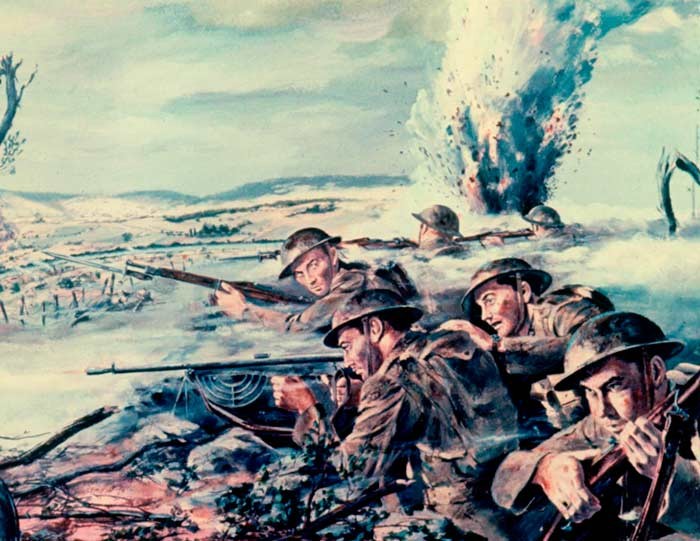
Diplomatic and political tensions among the empires of Europe exploded in a global war in August 1914. The United States remained officially neutral as the conflict raged on both land and the high seas, from the lush islands of Micronesia to the deserts of the Near East and from sub-tropical Africa to the entire continent of Europe. When Germany unleashed a policy of unrestricted submarine warfare, America responded with a declaration of war on Germany on April 6, 1917. The American army needed to quickly mobilize beyond its standing strength of 135,000. The Allies (France and Great Britain) had requested an immediate Aca,!A"show of force,Aca,!A? and the U.S. responded by sending the 1st U.S. Infantry Division to the major seat of war, the so-called Western Front in France. General John Pershing, commanding the newly-established American Expeditionary Forces, advised his superiors that a total force of one million men should be on the ground by May 1918. For almost a year, division after division of American Aca,!A"doughboysAca,!A? occupied training areas in the rear of the assigned U.S. sector in the French Province of Lorraine, with a much smaller number deployed to northern Italy to defend the Alpine border against the forces of the Austro-Hungarian Empire. Senior American military and civilian leaders both viewed their troops as a cooperative supporting venture to the Allies, but insisted that the identity of US forces had to be preserved as a separate and distinct element of the combined force.
Pershing did his best to comply with this directive, but the situation in France and Belgium was particularly tenuous following mighty German offensive actions of the spring. In March and April 1918 the so-called Aca,!A"Ludendorff OffensivesAca,!A? had advanced enough to threaten North Sea ports, largely defended by British troops, and Paris, largely defended by French Armies. American forces participated in numerous actions instrumental in reversing German gains from May until September, but always as part of an Allied command. Some of these actions are fairly well-known: Cantigny, north of Paris, on May 28; at the Marne River near ChAfActeau-Thierry on May 31; Belleau Wood through most of June. Other locales are absent from common knowledge: Lucy-le-Bocage and Bouresches in early June; Vaux in late June. But in these actions, and many others, large and small, Americans fought under non-American command. This would still be the case with the first massive American battlefield presence in mid-July.
A German attack had resulted in a triangular salient between the Aisne and Marne Rivers, pivoted on the west at Soissons and on the east at Reims, with the point located at ChAfActeau-Thierry. Americans joined French forces attacking from three directions, and one day later the Germans began to retreat. From the salient apex, they withdrew over 20 miles to positions behind the Aisne River, opening the door for an Allied offensive, which would come later in 1918, this time with the American Expeditionary Forces under the independent command of General Pershing.
The July 18 attack is vividly described in a detailed account, now part of the Military History InstituteAca,!a,,cs World War I Veterans Survey Collection, from which one can virtually feel the tension of this battle. First Lieutenant Ladislav Janda described the experience of his Company M, 9th Infantry Regiment of the 2nd Division:
Aca,!A"Certainly no one who went thru it will ever forget it. Night fell early in the forest and a steady rain set in. The road became muddy and slippery and as we approached the center of the woods congestion became terrific. The French were trying to pull out while the Ninth, and Twenty Third Regiments, Marines and rolling stock were struggling against fatigue and time, to get into position in time for H hourAca,!A|.The men had settled into a dogged silence, the whole Regiment strung out in a single file, going up the road in the ditch alongside of the road, each man holding on to the belt of the man ahead of him so that contact might not be broken. They were too tired to care much what happened. Collapses were frequent. A man would silently drop and the column would close up again. Brains were stupefied but somehow the bodies kept on going.
Aca,!A"Suddenly, at 4:35 to the dot, a livid flame seemed to shoot up out of the entire forest behind us and seemed to hang there as our guns opened up one continuous roar of bombardment that was deafening. Instantly the front came to life. There was a wild clattering of machine guns and lights of various colors flying in all directions. At the same time the Regiment surged forward. I believe that the First Battalion must have been literally pushed over the German first trenches by the sheer weight of men behind it. The din at this time was terrific. Vocal commands and whistle were out of the question--arm signals alone were of any use.Aca,!A?
Janda continues with a detailed description of the dayAca,!a,,cs combat action, during which he had sustained a serious leg wound, but stayed in touch with his company during another attack in early evening. Later that night he was evacuated first to the Villers CotterAfA(th)ts Forest, then further to the rear for advanced medical attention.
The success of these operations reinforced the positive outcome of earlier actions and resolved once-and-for all any questions of the fighting capability of the American Aca,!A"doughboy.Aca,!A?
Related Links:
A Working Bibliography of MHI Sources: World War I - German Offensives
Working Bibliography of MHI Sources: World War I - AEF Overview

Social Sharing